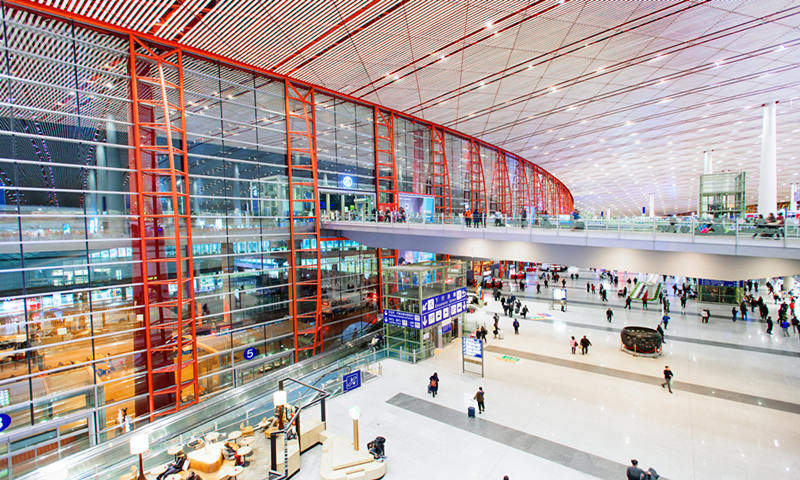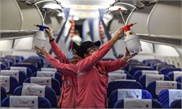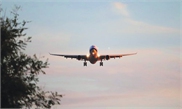SOURCE / MARKETS
More international flights expected to land, take off from Beijing
Recovery of international education, business and tourism expected

Terminal 3 of Beijing Capital International Airport Photo: VCG
Beijing said it will gradually resume direct international flights starting Thursday as the COVID-19 outbreak has been contained, and it is widely believed there will be more international flights landing and taking off from Beijing soon.
The Chinese civil aviation regulator announced on Wednesday that starting from Thursday, nine flights will operate from eight countries that have reported fewer infections, including Thailand, Cambodia, Pakistan and Canada, according to a statement on the website of the Civil Aviation Administration of China (CAAC).
"It is a milestone victory against the backdrop of the pandemic still raging in many countries, and also shows the overseas aviation market in China will be gradually back to normal operation," Qi Qi, a market watcher, told the Global Times on Thursday.
The move follows the resumption of domestic flights, driven by the effective control of the virus in the country.
A report released by information provider VariFlight showed that driven by the summer peak season, the number of domestic flights in August continued to maintain a steady trend, and the overall situation has been close to the same period last year.
But affected by the pandemic overseas, the number of international flights operated by Chinese mainland carriers is still small, only 10 percent of the same period last year, the report said.
As Beijing now allows international flights to land directly, there will be more in and outbound flights, Lin Zhijie, a market watcher, told the Global Times on Thursday.
The first direct international flight operated by Air China from Phnom Penh, capital of Cambodia, landed at the Beijing airport on Thursday morning.
In a flight plan, Air China said from Tuesday to October 23, it will fly a total of 28 international routes each week, including 19 connecting flights to Beijing, three international routes to Shanghai, three to Hangzhou, and three to Chengdu.
But Air China said the first landing airport for the above-mentioned flights may change.
In a document sent to the Global Times, VariFlight said three flights by Air China are expected to land at Beijing Capital International Airport on Thursday, from Moscow, Phnom Penh and Dubai.
With the resumption of direct flights to Beijing, there will no doubt be more international flights in and out of China, and it is good for airports that originally accounted for a relatively high proportion of international flights, as well as for the recovery of international education, business, and tourism markets, Zheng Hongfeng, CEO of VariFlight, told the Global Times on Thursday.
However, airlines still take a wait and see attitude on resuming flights to Beijing, as the regulator has a strict control on the flights.
In order to control the cross-border spread of the virus, the CAAC said on Wednesday that it would impose stricter anti-COVID-19 prevention measures based on an existing "circuit breaker" mechanism.
The regulator stressed that if three or more confirmed cases are found on an international flight into Beijing, the flight will be re-directed to other Chinese cities, while the number of overseas passengers arriving at Beijing Capital International Airport will be limited.
During trial operations, direct international flights to Beijing will have a passenger cap of around 500 each day, and they will be tested for COVID-19 twice and sent into collective quarantine for 14 days, according to the authorities.
The CAAC also said on Tuesday that it will strictly control inbound passenger flights, and passenger loads for inbound flights from regions with a high risk of COVID-19 will not be allowed to exceed 75 percent, following the country's continued experience of receiving imported coronavirus cases.
The International Air Transport Association (IATA) announced on Tuesday that passenger demand in July (measured in revenue passenger kilometers or RPKs), continued at critically low levels - 79.8 percent below July 2019 levels.
Chinese carriers' traffic was down 28.4 percent compared to July 2019. Recovery had slowed modestly in June amid new virus outbreaks but resumed its pace from mid-July, the IATA said.
Beijing has imposed strict controls on outbound flights since the epidemic outbreak.
In March, China's air regulator set up a special team to divert arriving international flights from the capital city of Beijing to other Chinese cities, with more than 10 airports located in cities such as Shenyang, Dalian, Tianjin, Shijiazhuang, Taiyuan, Hohhot, and Shanghai being asked to help relieve pressure of rising passengers at Beijing's Capital International Airport.




